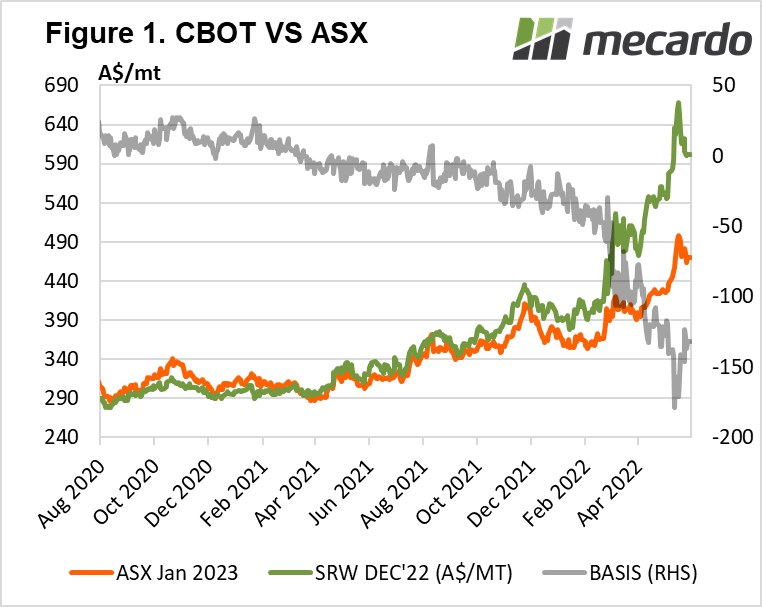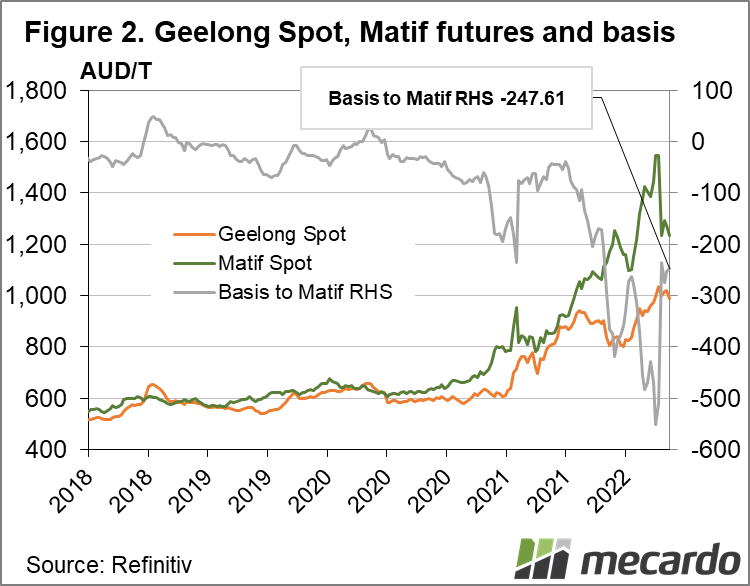When prices are at extreme highs it is good for producers and bad for consumers, and it’s easy to take the “do nothing” approach to hedging. Consumers will wait for prices to fall, and producers will make great profits even if the market loses 20%. There are still opportunities, however, for those willing to take a position.
Extreme prices and volatility often see markets get way out of their normal relative ranges. In a global market, the price of grain from a net exporter should follow those of competitors closely. If prices here get to a large discount to those in the US, buyers come to Australia, and prices push higher until the net landed price is the same again.
At the moment we are seeing a huge discount in Australian grain markets due to a large crop and highly volatile international markets. Figure 1 shows ASX Wheat Jan-23 Futures and Chicago Soft Red Wheat (SRW) December 22 contract.
It’s hard to believe the ASX futures were at a premium to SRW back in 2020. During the 21-22 harvest the ASX discount was historically large at $30/t. In the last month, ASX has been at as much as a $180 discount, and is now back at negative $130. The large swings are almost entirely due to the well-documented volatility in the US market.
With local wheat so highly discounted the opportunity for growers is to sell SRW, with the expectation that ASX prices will hold in the face of falling US values. This is what we have seen over the last fortnight, but the discount has another $100 to squeeze in before we are back in the ‘normal’ range.
For many consumers forward buying physical or ASX wheat in the mid $400s would seem unpalatable. However, prices are cheap in a relative sense. There is a case to be made for buying local, and selling SRW futures. This strategy would see the consumer benefit if the spread tightens, either through SRW falling (futures profit) or physical rising.
The story is similar for canola, with heavy local discounts and highly volatile international markets. There are not many producers that are able to stare at $1000/t and leave it be, but selling futures at $1200 with the expectation that local prices move back within $80 is likely to give a better result.
What does it mean?
Participating in futures markets during extreme volatility isn’t for the faint-hearted, but the rewards will be strong if ever markets return to something near normal. There are also options which can be used, which require an upfront expense but limit losses to that amount. The problem in volatile markets is that options are very expensive, but they can have a strong payoff.
Have any questions or comments?
Key Points
- Extreme prices, volatility and strong local supplies see heavy discount for Australian grains.
- Despite high prices in historical terms, wheat and canola are highly discounted to international benchmarks.
- There are opportunities for both consumers and producers in the current market.
Click on figure to expand
Click on figure to expand
Click on figure to expand
Data sources: Refinitiv, Mecardo















